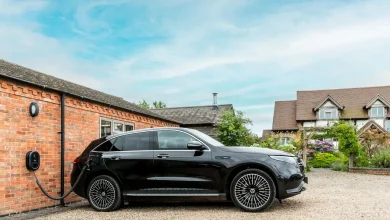How far can an electric vehicle travel on a single battery charge? Good news? Far more than people believe.
Modern battery technology is improving each year. EV manufacturers continue to release models with improved ranges, efficient drivetrains and energy-management systems. Electric vehicles are available for all types of drivers, whether you are a commuter daily, cruising the motorway long distances, or a weekend adventurer.
This comprehensive guide will cover EV Range Battery Life, Charging Habits, Range Anxiety and practical tips to maximise your car’s performance. You’ll know everything you need by the end to choose the best electric vehicle for you.
How far can an Electric Car go on a single charge?
In the late 2000s, when electric vehicles returned to the market, a range of 100 miles was considered impressive. The landscape has changed dramatically in the last few years. Several high-end EVs can now reach 200 or more miles, and many modern EVs can go beyond 300 miles with a full battery charge.
Examples of Modern EV Range
We’ll look at a few models today to see how far the technology of EVs has progressed:
- MINI Level 1 Electric – Around 144 Miles
- Up to 379 Miles Tesla Model S long range
- Mercedes-Benz EQS Saloon 487 miles in a day (WLTP)
These numbers make it clear that there is no longer a barrier for the majority of drivers.

Why do Electric Vehicle Ranges vary Between Models
The range of a battery depends on many factors. However, the size (measured in Kilowatt-hours) is the most important. In simple terms:
The larger the battery (higher in kWh), you can drive more miles on a single charge.
Many EVs come with multiple battery choices. Consider models such as the Tesla Model 3 and Volkswagen ID. 3. Choosing the larger battery can add dozens or hundreds of miles to WLTP’s range.
Other Factors that Affect the EV Range
Range is also affected by:
- Vehicle aerodynamics and size
- Driving Style
- Tire type and pressure
- Outside temperature
- Types of roads (motorways and city driving)
- Battery cooling/heating efficiency
It is normal for a car to have a greater range in the summer but a lower range in the winter. This is because fuel consumption in diesel and petrol cars can vary depending on temperature and driving conditions.
WLTP vs. Real-World Range (RWR): What is the difference?
You’ll find two different types of range numbers when researching an EV:
1. WLTP Range (Official Test)
The acronym WLTP is Worldwide Harmonised Light Vehicle Test Protocol. This is the official measurement that manufacturers and regulators use. WLTP was designed to give a standard estimate. However, it is often based on ideal driving conditions and not necessarily real-world driving.
2. Real-World Range
Real-world ranges are typically 10-20% less than the WLTP, depending on factors such as temperature and speed. Real-world estimates are based on factors such as:
- Seasonal Differences
- City driving vs. highway driving
- Air-conditioning/heating use
- Acceleration and regen-braking patterns
Example: Kia Niro EV (64.8 kWh)
- Range of WLTP: High-200-mile bracket
- Range in Real World: A little lower but more accurate.
Real-world numbers help you get a better idea of how your EV performs daily.
How long do electric car batteries last?
The biggest myth about EVs is that the batteries need to be replaced regularly or degrade rapidly. Today’s lithium-ion EV battery is highly reliable and designed to last for thousands of miles.
EV Battery Lifespan
Battery life is a major concern for most EV owners.
- On average, it is around 10 years old
- Depending on usage, it can last between 15-20 years.
Some Tesla batteries are capable of exceeding 1,000,000 kilometres (over 621,000 miles) without any degradation.
Why EV Batteries Last so Long
The battery management systems (BMSs) of EVs are sophisticated.
- Avoid overcharging
- Regulate the temperature
- Natural degradation can be slowed down
- Battery protection against excessive load
These systems are much more advanced than the ones you find on laptops or phones.

Do EV Batteries Need Replacing?
In practice, batteries fail very rarely. Battery replacements are almost non-existent at DriveElectric. We have more than a decade of experience in EVs.
How to protect and prolong your electric car battery
Even though EV battery life is incredibly long, there are some smart habits you can adopt to maximise it.
1. Charge up to 80% Whenever Possible
Geotab and other EV battery experts have conducted research.
Charge your battery to 80% daily for long-term health.
Many EVs come with built-in settings to limit the charge to 80%.
2. Batteries should never be left empty or full.
Keep the battery in your car between:
- 20-80% for best long-term health
3. Use Rapid Charging Occasionally, but Not Exclusively
Rapid charging is safe, but excessive use can cause a slight degradation over time. It is okay to use rapid charging occasionally, but it is best to charge your phone at home or work every day.
4. Cool Your Battery and Cabin
Heat is a major threat to the health of batteries. Thermal-management systems are available on EVs, but parking under shade or in a garage can reduce the stress placed on the battery.
How often should I charge my electric car?
How much you drive will determine the answer.
UK Car Usage
Department of Transport data shows
- Average mileage of 7,500 miles per annum
- 144 miles per week
- Just over 20 miles per day
The majority of drivers overestimate the daily mileage they drive.
What does this have to do with EV Charging
Your charging routine could look something like this:
- Full charge once a week,
- An hour every evening, depending on your setup
DriveElectric recommends a “little-and-often” strategy:
When possible, keep your EV between 20 and 80 per cent.
It will help to maintain the battery and make sure you have enough power for any unexpected trips.
Where can you charge an electric vehicle?
Now, there are more than ever before:
- Charge your phone at home
- Chargers for the workplace
- Chargers for on-street parking
- Rapid chargers for vehicles
- Hubs DC ultra-rapid, 150kW to 350kW
The charging infrastructure in Europe and the UK has increased significantly. Finding a charging station is now easier than ever.
Range Anxiety: Is it Still A Thing?
Range anxiety is the worry that your EV will not have enough power to reach your destination. Many people cite this as a reason to delay switching to electric vehicles, but is it still valid?
The Myth of Range Fear
Range anxiety is more of a mental barrier today than it is a real problem.
Here’s why:
- Non-EV drivers are more likely to mention it
- Modern EVs can travel between 140 and 350 miles on a single charge
- The charging infrastructure is growing rapidly
- Drivers adapt to real-life use within days
In 2012, a London Metropolitan University study noted that range anxiety among actual EV users was “almost nonexistent”.
What happens when new EV drivers switch?
After about ten days, most new EV drivers are no longer anxious. Drivers quickly learn:
- The true daily mileage
- What is the actual range of their electric vehicle?
- Top-ups are easy to do at home or on errands
There’s a good reason why EV surveys show that over 90% of drivers would never go back to petrol or diesel.
How to get the most range out of your electric car
The driving style you use can have a significant impact on the efficiency of an EV. You can increase your range by a significant amount with a few simple adjustments.
1. Reduce High-Speed Drive
Aerodynamic drag increases significantly above 65 mph. You can increase your fuel efficiency by lowering your motorway speed.
- 15% more range, depending on the vehicle
2. Use Regenerative Braking
Regenerative braking (also known as “regen”) is standard on most EVs. This feature recovers energy from the vehicle when you take your foot off the accelerator.
Tips for maximising regen:
- Change to higher regen mode
- Take off early as you approach junctions
- Brake smoothly and steadily
The simple act of adding a few extra miles can increase the distance travelled on each trip.

3. Tires should be properly inflated
Low tyre pressure can increase rolling resistance and reduce range. Check your tyre pressure often. EVs are heavier and more susceptible to under-inflation.
4. Pre-heat or precool while plugged in
If you have an EV connected to a charging station:
Plug in your climate control system to use the temperature control.
The cabin is heated or cooled using the grid and not your battery.
5. Travel Light
Roof racks and cargo boxes, as well as heavy loads, reduce efficiency. Remove all accessories when not needed.
6. Charge your phone on longer trips with fewer charging stops
Most EV drivers quickly adopt new travel habits:
- Planning a quick 15-20 minute rapid charge
- Breaks for coffee, stretching out, emailing, or food
- Mapping journeys using built-in sat-nav charging planners
It makes the journeys more comfortable and relaxed.
Final Thoughts:
Range is no longer an issue with today’s electric cars, which can travel 150 to 500 miles on a single charge. There’s a perfect EV for everyone, whether you commute in the city, drive on the motorway daily, or travel long distances.
What to consider when evaluating the EV range
- Calculate the range by looking at the battery size (kWh).
- Verify both the WLTP and the real-world figures to ensure accuracy
- Consider your daily mileage – most drivers drive far less than you think
- EV batteries are built to last and are extremely reliable
- Get the most out of your vehicle’s range by learning efficient driving habits
Electric vehicles are convenient and easy to drive.

